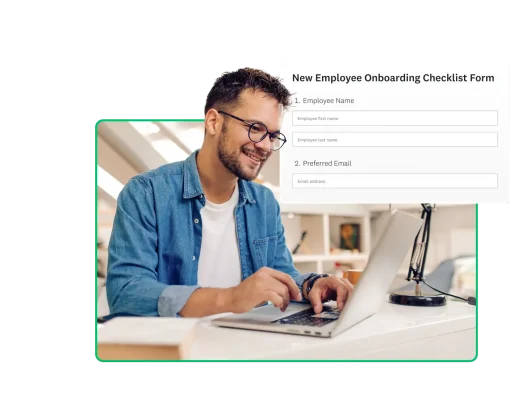Best practices for employee onboarding: How to set new hires up for success
Update your onboarding process with these top best practices from SurveyMonkey. Set new hires up for success with comprehensive employee onboarding.

Employee onboarding is more than just a chance to inform new employees about their roles and responsibilities. It's also a time to introduce them to the company's culture and provide the necessary resources to succeed. However, many companies aren’t fulfilling the purpose of onboarding, with 52% of employees feeling untrained after completing the onboarding process.
In this article, we will explore the purpose of employee onboarding, its importance, how to build a stellar onboarding program and share best practices to consider for your business.
What is employee onboarding?
Employee onboarding occurs after a candidate is hired and consists of integrating the new employee into a company by educating them on their job duties, company policies, and culture and providing training resources to ensure they feel prepared to hit the ground running.
The employee onboarding process is similar to boarding a plane. When people board a commercial flight, the flight attendants briefly brief them on the airplane’s policies and culture, safety features, resources for further education, and what to expect during the flight. In the same way, employee onboarding covers the basic things a new hire should know about a company, their role, and how to thrive in their new position.
Why is the employee onboarding process important?
A great onboarding experience sets the tone for new employees and provides them with the knowledge and resources to be productive and efficient in their job responsibilities. Additionally, ensuring you have a well-developed onboarding process for employees improves retention, reduces costs, strengthens company culture, and boosts engagement and productivity.
Improve retention and reduce turnover costs
According to a survey by Korn Ferry, 98% of CEOs and hiring managers believe the onboarding process is a key factor in employee retention. This statistic shows how important creating a comprehensive onboarding process is for a company’s retention efforts. With a solid first impression and sufficient training, new employees are more likely to feel satisfied with their roles instead of jumping ship after a short time.
Improving retention also reduces turnover costs, which can considerably burden many companies. The average cost to replace an employee can be as high as 50%-60% of their salary, with overall losses reaching 90%-200%. For example, if an employee makes $65,000 annually, it could cost $32,500 to $39,000 to replace them and $58,500 to $130,000 in total company losses.
Reduce onboarding costs
Being strategic in your onboarding process and how you train new employees can reduce onboarding costs. For instance, if you invest in onboarding software, it may be a hefty cost upfront, but it will significantly reduce the ongoing cost of onboarding. There are benefits to streamlining the onboarding process and utilizing advanced technology, such as reducing costs, saving time, and providing more thorough training.
Strengthen company culture
The employee onboarding process is a time to let your company culture shine. Whether this means providing company swag to new employees or hosting a “get to know the team” session, new employees should feel welcomed into your company culture with open arms.
Setting expectations for company culture, communication styles, and team collaboration strengthens company culture. By making your company culture clear from the beginning, new hires can feel confident embracing it.
Boost employee experience and engagement
Employee experience (EX) and engagement are vital components of a satisfied workforce. These two metrics ensure employees are actively engaged and happy in their roles. During onboarding, new employees may meet with HR reps and company leaders to learn about included benefits, company goals, the tech stack, and more. An effective onboarding program will generate enthusiasm and promote commitment to the company.
Boost EX and engagement by immersing new hires in company culture, demonstrating the values, and displaying a positive work environment.
Improve employee productivity
A proper onboarding process also enhances employee productivity. By sharing the tools and resources available, employees are well prepared to tackle challenges they may face in their new roles. Additionally, introduce the team and designate a mentor to ensure that recently hired employees have someone to contact when questions or issues arise.

How to build an employee onboarding program
There are five key pillars essential to building a fantastic employee onboarding program. Each one plays a role in the overall effectiveness of the process.
Compliance
Compliance training ensures new hires know and comply with company policies, procedures, and legal requirements. To do this effectively, develop an onboarding module that covers essential policies and procedures such as attendance, sick leave, and vacation policies and the use of company resources such as computers, email, and internet access.
Additionally, you should discuss any legal requirements the company must comply with, such as occupational health and safety regulations, equal employment opportunity, and workplace harassment policies. New employees should feel empowered with the knowledge they gain during onboarding.
Clarification
Develop and share a comprehensive job description before their start date so new hires fully understand their roles, responsibilities, and performance expectations. Clarify their role, responsibilities, and performance expectations by developing a comprehensive job description document. This document or presentation should also have goals and objectives for the first 30, 60, and 90 days of employment.
HR teams should also provide easy access to training and development opportunities that support the new hire's role and career goals. Planning the ramp into meaningful work is slowly introducing work to new hires throughout onboarding, allowing them to ask any questions.
Culture
To set culture expectations, ensure that new hires understand the company's values, mission, norms, and customs. Provide opportunities for the new hire to participate in company events and initiatives to help them acclimate to your company culture.
Also, encourage new employees to share their perspectives and experiences with the team. Fresh ideas and unique perspectives can always improve company culture. Involve stakeholders such as managers, colleagues, team members, and company leaders in the culture initiation.
Connection
New hires should build relationships and networks within the organization to create more cohesive teams and support better collaboration. Arrange for every new hire to meet with key personnel and departments, so everyone has the chance to form connections.
Assigning a mentor or buddy to help the new hire navigate the organization and build relationships is recommended. This mentor can encourage the new employee to participate in team-building activities and social events and get engaged in online platforms like Slack channels or social media groups. Lastly, be sure to send an announcement to the company about the new hire before their start date.
Check-in
HR teams should schedule regular check-ins with the new hire's manager to provide feedback and track goals. Companies can also check in with onboarding surveys and quizzes, interviews, and 1:1 meetings, whether virtually or in person.
How to evaluate your employee onboarding program
When revamping your employee onboarding program, it is important to use both qualitative and quantitative data to evaluate the effectiveness of the employee onboarding program. There are several ways to gather this data, including:
- Surveys and quizzes: Use onboarding surveys to collect employee onboarding feedback and make improvements for future new hires. Companies can also consider using short quizzes to determine whether the onboarding process effectively shares important company information employees need to know. Applicable surveys include:
- Interviews and check-ins: Checking in on employees regularly allows managers to gauge how new hires feel about their roles and answer questions or address concerns. You can conduct regular check-ins with 1:1 meetings or via weekly surveys like this Week 1 Onboarding Check-In survey template.
- Key performance indicators (KPIs): When evaluating an onboarding program, knowing what KPIs to measure is critical. KPIs to track include:
- Turnover rate
- Retention rates
- Time to productivity
- Number of onboarding milestones completed
Employee onboarding program best practices
When it comes to employee onboarding, there are a handful of best practices HR professionals should be following. For the best results, follow these best practices for onboarding.
- Set expectations and minimize surprises: To minimize surprises, set expectations and communicate them to all stakeholders in the onboarding process (current team members, new hires, managers, etc.)
- Provide resources: Use an onboarding checklist template to help employees prepare for the onboarding process. This checklist helps integrate new employees smoothly and provides a positive experience. Be sure also to provide resources like agendas, org charts, an employee directory, company history, welcome packages, employee handbooks, manuals, etc.
- Invest in preboarding: Preboarding takes place before a new hire’s first day on the job. It involves sending and reviewing important paperwork in advance, such as tax forms, identification, and direct deposit account information. Maintain contact with new hires before onboarding to keep them in the loop before they begin work.
- Invest in onboarding software: Onboarding software is designed to streamline the onboarding process for HR professionals and new employees. Investing in user-friendly onboarding software helps companies create standardized onboarding for new hires that is comprehensive, effective, and cost-efficient.
- Improve your onboarding processes continuously: Evaluate and adjust your onboarding process regularly to ensure the best employee experience. Use employee feedback from surveys to implement changes that improve the onboarding process and candidate experience.
Onboard employees faster and easier with SurveyMonkey
Now that you understand the importance of a well-developed employee onboarding and training process, it’s time to implement these best practices. Create the best onboarding experience for new employees by checking in frequently, setting expectations, and providing support where they need it.
Learn how SurveyMonkey makes it easy to build employee onboarding processes with surveys.
Discover more resources

Attract, engage, and retain top talent with data-driven insights
Create powerful HR surveys with SurveyMonkey to gather feedback, boost engagement, and improve workplace culture. Streamline HR processes with customizable templates.

Why are surveys important in research?
Surveys are important in research because they offer a flexible and dependable method of gathering crucial data. Learn more today.

Job application surveys
Survey job applicants online to get a good understanding of your recruitment process strengths and weaknesses. Free templates and survey advice, sign up today!

HR Survey Questions: 80 Examples & Best Practices
Discover 80 HR survey questions, best practices, and tips for success to improve employee engagement.